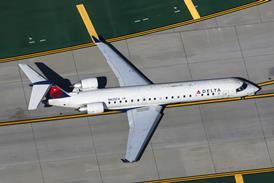RICHARD PINKHAM LONDON
British Airways is finding that using franchise carriers at its London hubs is proving a mutually advantageous example of industry strategy
British Airways has been engaged in some highly public soul-searching about its future size and shape. In the process it has overturned much of the strategy of the last decade. However, one element that has emerged from the reviews intact is the pioneering use of mainline franchise partners.
The franchise experiment began in 1990 as a largely regional affair, when BA signed up CityFlyer to provide feeder service at London Gatwick. It went on to add a host of other regional partners, also extending the experiment to include mainline operators such as GB Airways and British Mediterranean Airways (BMed), both providing medium- to long-haul service from BA's London hubs. Comair was also signed up in South Africa and closer to home Maersk (although with a largely regional fleet), also operates three Boeing 737s in BA colours from its base in Birmingham.
The regional partners, including CityFlyer, have now mostly been acquired and wrapped into a new BA unit. But the mainline franchisees have survived and thrived. Roger Maynard, BA's director of investments and alliances, says that from the outset the aim was to extend the carrier's brand into new markets without expending capital, and that objective remains in place.
Hub partners
BA's first franchise to operate non-regional aircraft from a hub was GB Airways, which became a franchisee in 1995. GB flies all but three of its 22 daily departures from Gatwick, serves mostly leisure-based, destinations in the western Mediterranean region and operates a mixed fleet of 737s and Airbus A320 family aircraft - which will become all Airbus by 2004.
BA signed its franchise agreement with BMed in 1997 (see related article page 62). That carrier flies an all-Airbus fleet in transporting predominantly business and ethnic traffic to 12 Middle East, Horn of Africa and central Asian destinations from its base at Heathrow.
The two carriers serve vastly different markets, but achieve the same ends for BA. The terms of their relationship with the franchisor are also similar, although BMed's is open-ended, while GB's expires in 2008. Both use BA's ground handling operations at the London hubs, as well as its systems for IT, sales and marketing, revenue management and accounting.
They both also pay BA a franchise fee - calculated on the basis of revenue - for the use of its brand. However, distinct from other franchises - and most beneficial to BA - the two bring hundreds of thousands of connecting passengers into the hubs, and add 33 destinations to the route map. This means passengers in those cities can now fly BA, and it satisfies the needs of its passengers elsewhere in the world.
For the franchisee, the principal attraction of the arrangement is overwhelmingly the ability to sell itself as BA and use the distribution system of one of the world's largest airlines. GB managing director John Patterson, who formerly served as head of alliances at BA, calls this component "the mainspring of the relationship".
The Comair experience in South Africa is a case in point. The carrier benefits in terms of traffic, feeding passengers on to BA's two daily London flights out of Johannesberg - connecting with three domestic destinations and four other southern African cities. More importantly, it also derives significant marketing benefits from its link with the UK giant. Having the British Airways livery on its fleet of Boeing 727s and 737s has played a big role in Comair's ability to capture significant share in the regional point-to-point market. "Africa is a market where the halo effect of the brand is especially important," says Maynard.
For the London-based franchises, the relationship also represents a mechanism for significant cost savings. For example, Hetherington explains that BMed now falls under BA's insurance policy, something he says brings the carrier's aircraft premiums down by approximately two-thirds. There are also savings from the use of BA's revenue accounting system. Hetherington says that this necessary activity is usually an onerous cost for a smaller airline, but that having its operations folded into BA's has resulted in a 20% fall in related expenditures.
Some outsiders question why BA would choose to give potentially lucrative hub flights to third parties. Numerous factors influence the decision. Hetherington cites as one the ability to focus on a region, something BA, with "its plate full with the other 180 destinations it serves", is unable to do. Maynard adds to the list intimate familiarity with a specific market, such as GB has gained through years of serving the Iberian peninsula. The ultimate driver for this symbiotic relationship, however, is the lower cost structure of the franchisees.
Hetherington says: "BA has admitted there are things it cannot do and one of them is profitably fly long, thin routes, such as London to Tbilisi or Addis Ababa. If we didn't produce seats cheaper than BA, they would still serve these markets." He adds that his carrier's unit costs for the first quarter of 2002 were 40% lower than those of BA. GB, too, enjoys a healthy cost advantage with unit seat costs of 4.37 pence (6.75¢).
Both franchisees cite similar themes when discussing their ability to keep costs low. Aircraft utilisation is among the more important. BMed has its A321s in the air almost 10 hours a day and its A320s over 13. GB - with a 45% shorter average stage length - posts almost 11 hours a day, which compares favourably with the seven hours logged by BA's Gatwick-based short-haul fleet.
Both carriers also have the ability, as smaller airlines, to aggressively cut out cost-creating complexity. As Patterson says: "It's a state of mind - we don't need the overheads a big company will - no deputies or co-ordinators - and we're less complicated: we don't have to deal with engineering, handling and cargo, and we subcontract whenever possible."
Relationship management
With both carriers recognising the value of the franchise, they are naturally committed to ensuring BA is satisfied. Patterson says: "We take the nurturing of the relationship as a key task. It's easy to think life is tough when you're in bed with a gorilla, but you really do need to deliver what the franchisor wants."
Maynard hints at what BA chiefly looks for from its franchisees when he says: "We haven't revoked a franchise agreement yet, but we do monitor safety and customer service very carefully"
Not surprisingly, both BMed and GB make meeting those criteria their highest priorities. Hetherington bluntly says that "you cannot spend too much on safety", and has made ensuring safe operations a personal crusade. For his part, Patterson says that in addition to maintaining the highest level of carrier safety, his key priority is to "strive to make sure that our standards are better than BA's and that the brand is delivered without the passenger seeing the join between the two companies".
With the value to both sides so evident, the only question would seem to be why the model is not applied more widely. In part, the answer lies with labour rules. Maynard points to the relatively flexible nature of UK deals compared with the scope clauses enshrined in US contracts. "Labour relations in the UK are consensual and pragmatic, not legalistic," he says. "Employee groups, while having questions about them, understand the value of the franchise."
A spokesman for the British Air Line Pilots Association basically agrees, saying: "While we do not like franchises very much, we're not opposed to them." He adds that the issue of BA's use of the two London-based carriers is not likely to appear on the negotiating docket anytime soon, with the union electing to focus instead on mainline pilot wages and work rules.
Thus, BA appears basically ensured of being able to continue its hub-franchise policy. And will it? Patterson seems unlikely to lose any sleep asking himself that question. "It's such a win-win situation," he says, "that abolishing it is outside rational thought." n
| British Airways London-based franchises - 2001/2 | |||
| GB Airways | BMed | ||
| Passengers | thousands | 1,303 | 212 |
| Traffic | RPK million | ||
| Load factor | per cent | 74% | 64% |
| Destinations | number | ||
| Fleet* | number x type | 5xA320 2xA321 4x737-300 | 3xA320 2xA321 |
| Note: Figures for year to 31 March 2002. *Fleet is at October 2002. RPK = revenue passenger km 1 mile=1.609km | |||
Source: Airline Business























